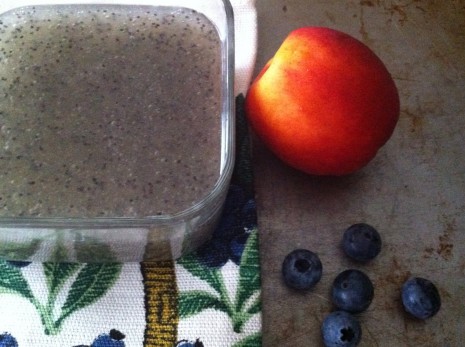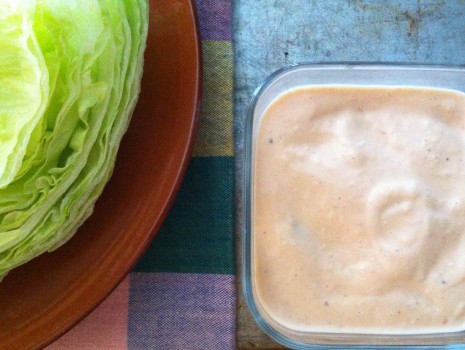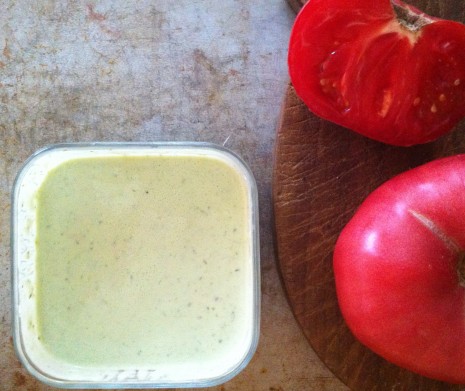THREE CLASSIC AMERICAN SALAD DRESSINGS
A recent encounter with a restaurant salad drenched in a thin, too-sharp vinaigrette left me pining for richer dressings, those with swagger and substance. Green Goddess is one such treasure: Anchovies give it a deep resonance and tarragon, a bright, joyous peal of flavor. It’s most famously served over avocado, but it is also superb with asparagus, romano beans, or seafood. It’s also pretty great in deviled eggs.
I have three more swear-by dressings in this category: poppy seed, Thousand Island, and ranch. They’re familiar to anyone who has ever walked down the dressings-condiments aisle at the supermarket, but flavorwise they may as well be from another planet. The first ingredients you’ll find listed on bottled dressings are usually high-fructose corn syrup and soybean oil, followed by a dreary line-up that includes artificial flavors, stabilizers, and preservatives. Life is too short for that sort of muck, so do as I do and make the dressings at home. You’ll discover that they’re delicious and easy to whiz up in a blender—just right, in fact, for a long weekend full of casual food. They will also send everyone at the table over the moon.
The creator of poppy-seed dressing (see above photo) is generally acknowledged to be Helen Corbitt (1906–1978), the widely influential Texas cooking authority who also gave the world Texas caviar—and who, in 1955, became director of food services for the Zodiac tearoom at Neiman-Marcus, in Dallas. I use the word creator advisedly, for Corbitt begged to differ. “Where it originated I have no idea,” she wrote in her 1957 cookbook. “I did popularize it when I realized that on the best grapefruit in the whole wide world [Texas grapefruit] it was the most delectable dressing imaginable.”
That is still true today. The sweet yet balanced dressing is also wonderful with the peaches, nectarines, melons, and berries of late summer; you may want to pair a fruity salad with ham or pork. It has a real affinity for a spinach salad, and I also love it in a carrot slaw. It is a great gateway dressing or dipping sauce for children (or grown-ups) who might otherwise balk at eating their fruits and veggies.
Helen Corbitt’s Poppy-Seed Dressing
Adapted from Helen Corbitt’s Cookbook (Houghton-Mifflin, 1957)
Makes 1¾ cups
Here, I’ve halved Corbitt’s original recipe. The onion juice is “obtained by grating a large white onion on the fine side of a grater, or by putting the onion in a blender, then straining the juice.” As for the poppy seeds, I advise you to buy a fresh bottle and taste them first, to make sure they’re not rancid.
¾ cup sugar
1 teaspoon dry mustard
1 teaspoon salt
⅓ cup vinegar (I use white-wine vinegar)
1½ tablespoon onion juice (see headnote)
1 cup vegetable oil (not olive oil; use safflower or organic canola oil)
1½ tablespoons poppy seeds
Mix the sugar, mustard, salt, and vinegar in a blender at low speed. Mix in the onion juice. Gradually mix in the oil. When the dressing is thickened, gradually mix in the poppy seeds until they are well blended.
Thousand Island dressing was a 19th-century invention, created in the resort town of Clayton, New York, by Sophia LaLonde, the wife of a fishing guide in the Thousand Islands archipegalo of the St. Lawrence River. It was popularized first at the Herald Hotel (now the Thousand Islands Inn), in Clayton, and then at the Waldorf-Astoria, in Manhattan—the hotel’s owner, George C. Boldt, summered near Clayton in typical Gilded Age fashion.
Thousand Island dressing is mayonnaise-based and gets its pale color—and a welcome tang—from ketchup-style chile sauce. Some permutations contain pickle relish or chopped pimientos and/or green bell pepper, but I’m not crazy about the nubbly bits. I prefer the version below, from The Gourmet Cookbook, because it is perfectly smooth and voluptuous. Ribbon it over a wedge of crunchy, succulent iceberg lettuce, another great American culinary icon (developed in 1894 from an 1820s progenitor) that is overdue for a renaissance. Use it as a dip for the long slender inner leaves of romaine, or as a condiment for a chicken or turkey sandwich.
Thousand Island Dressing
From The Gourmet Cookbook (Houghton-Mifflin, 2004)
Makes about 1½ cups
2/3 cup mayonnaise
4 teaspoons ketchup-style chili sauce [such as Heinz]
2 tablespoons chopped shallots
1 tablespoon white-wine vinegar
2 teaspoons Dijon mustard
¼ treaspoon salt
1/8 teaspoon freshly ground pepper
½ vegetable oil [safflower or canola]
Combine all the ingredients except oil in a blender and blend until smooth. With the motor running [at slow speed], add oil in a slow stream and blend until well blended.
Would the salad bar phenomenon have happened without ranch dressing? I doubt it. The creamy buttermilk dressing is easy to love; in fact, it’s America’s bestselling salad topping. It was created by Steve Henson, the proprietor of the Hidden Valley dude ranch, near Santa Barbara, California, in the 1950s. Guests began taking it home in Mason jars, and soon Henson developed a packaged blend of dried herbs and spices, for mixing with fresh buttermilk and mayo. Before you could say “ka-ching!,” a multimillion-dollar business was born.
Henson never copyrighted the name “ranch,” so these days, various companies sell similarly flavored products. Clorox bought the rights to Henson’s dressing in 1972 and ever since has sold it under the Hidden Valley Ranch label. And now the company has developed a thicker version of the dressing to compete with ketchup. The company “is after your burgers, fries, and wings,” wrote Sarah Nassauer in the Wall Street Journal of April 4. Getting to quote the vice president and general manager for the food, charcoal, and cat-litter divisions of Clorox must have made her day.
The ranch dressing below, also from The Gourmet Cookbook, is based, I think, on a recipe from Sara Moulton. She has always liked to drizzle it over fried green tomatoes, but it is excellent over ripe red ones, too, as well as your favorite salad greens. Although it it thinner than the two dressings above, it still has great body and rich flavor—there is no need to add a whole lot to it. But you may want to make extra, so guests can take some home in a Mason jar.
Ranch Dressing (a.k.a. Herbed Buttermilk Dressing)
From The Gourmet Cookbook (Houghton-Mifflin, 2004)
Makes about 1¾ cups
1 cup well-shaken buttermilk
½ cup mayonnaise
2 tablespoons olive oil
1 tablespoon fresh lemon juice
1 garlic clove, minced
2 tablespoons chopped fresh chives
1 tablespoon chopped fresh flat-leaf parsley
¼ teaspoon salt
1/8 teaspoon freshly ground pepper
Combine all ingredients in a blender and blend until smooth.
Posted: August 29th, 2012 under cookbooks, culinary history, Gourmet magazine, people + places, recipes.





Comment from Cynthia A.
Time August 30, 2012 at 7:17 am
I will be adding all three of these to my recipe files! Thanks for putting them together in one post.